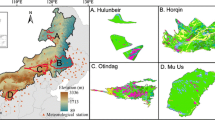Abstract
Land desertification is one of the world’s most important global ecological environment problems and sensitive to global climate change. In this study, Moderate Resolution Imaging Spectroradiometer (MODIS) and Gaofen-1 (GF-1) data were used to obtain aeolian desertification land distribution in Northern China. Aeolian desertification land distribution from 2001 to 2015 was used to analyze the spatiotemporal change in this area. Results show that aeolian desertification situation of 70 counties is expanded with low slope values and 250 counties is reversed. Aeolian desertification situation in most areas is improved in recent 15 years. Gravity center of the aeolian desertification has a trend to move towards the direction of the high latitude and low longitude. It moves towards north about 0.06° and west about 2.2° from 2001 to 2015. The main distribution area is between 90–100°E, 30– 40°N and altitude which less than 2000 m in desert and steppe climate zone. Aeolian desertification is worsening in recent 5 years around rivers and lakes. In recent years, the government has made great efforts to strengthen ecological construction with positive effect, but we still need to pay more attention to environment deterioration of rivers, lakes and the nearby areas in the future.









Similar content being viewed by others
References
Alfredo, C. D., Emilio, C. W., & Ana, C. (2002). Satellite remote sensing analysis to monitor desertification processes in the crop-rangeland boundary of Argentina. Journal of Arid Environments, 52, 121–133.
Badreldin, N., Frankl, A., & Goossens, R. (2014). Assessing the spatiotemporal dynamics of vegetation cover as an indicator of desertification in Egypt using multi-temporal MODIS satellite images. Arabian Journal of Geosciences, 7, 4461–4475.
Feizizadeh, B., Blaschke, T., Nazmfar, H., Akbari, E., & Kohbanani, H. R. (2013). Monitoring land surface temperature relationship to land use/land cover from satellite imagery in Maraqeh County, Iran. Journal of Environmental Planning and Management, 56, 1290–1315.
Feng, L., Jia, Z., & Li, Q. (2016). The dynamic monitoring of aeolian desertification land distribution and its response to climate change in northern China. Scientific Reports, 6, 39563.
Huo, A., Xie, J., Sun, Z., & Zhou, L. (2011). Methodology of land surface broadband albedo retrieval in the desertification area based on MODIS image data. In Water resource and environmental protection (ISWREP), 2011 international symposium (Vol. 4, pp. 2539–2542).
Karnieli, A., Qin, Z., Wu, B., Panov, N., & Yan, F. (2014). Spatio-temporal dynamics of land-use and land-cover in the mu us sandy land, China, using the change vector analysis technique. Remote Sensing, 6, 9316–9339.
Krishnappan, B. G., & Burrell, B. C. (2012). Using MOSAND to mitigate the desertification of Minqin Oasis, Gansu Province, China. Canadian Journal of Civil Engineering, 39, 72–80.
Lu, D., Batistella, M., Mausel, P., & Moran, E. (2007). Mapping and monitoring land degradation risks in the Western Brazilian Amazon using multitemporal landsat TM/ETM + images. Land Degradation and Development, 18, 41–54.
Schucknecht, A., Erasmi, S., Niemeyer, I., & Matschullat, J. (2013). Assessing vegetation variability and trends in north-eastern Brazil using AVHRR and MODIS NDVI time series. European Journal of Remote Sensing, 46, 40–59.
UNCCD (United Nations Convention to Combat Desertification). (1994). United nations convention to combat desertification in those countries experiencing serious drought and/or desertification particularly in Africa: Text with annexes. UNEP: Nairobi.
Vieira, R., Tomasella, J., & Alvalá, R. C. S. (2015). Identifying areas susceptible to desertification in the Brazilian northeast. Solid Earth, 6(1), 347–360.
Zhou, W., Gang, C., & Zhou, L. (2014). Dynamic of grassland vegetation degradation and its quantitative assessment in the northwest China. Acta Oecologica, 55, 86–96.
Acknowledgements
This work was funded by Foundation of Hebei Educational Committee (QN2018054, BJ2018043), Handan Municipal Science and Technology Bureau (1724230057-1, 1723209055-2), Forestry Public Benefit Scientific Research Special Project of PR China (201504420) and National Natural Science Foundation of China (31670706, 31600585).
Author information
Authors and Affiliations
Corresponding authors
About this article
Cite this article
Feng, L., Jia, Z., Li, Q. et al. Spatiotemporal Change of Aeolian Desertification Land Distribution in Northern China from 2001 to 2015. J Indian Soc Remote Sens 46, 1555–1561 (2018). https://doi.org/10.1007/s12524-018-0793-z
Received:
Accepted:
Published:
Issue Date:
DOI: https://doi.org/10.1007/s12524-018-0793-z




